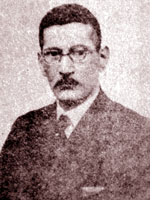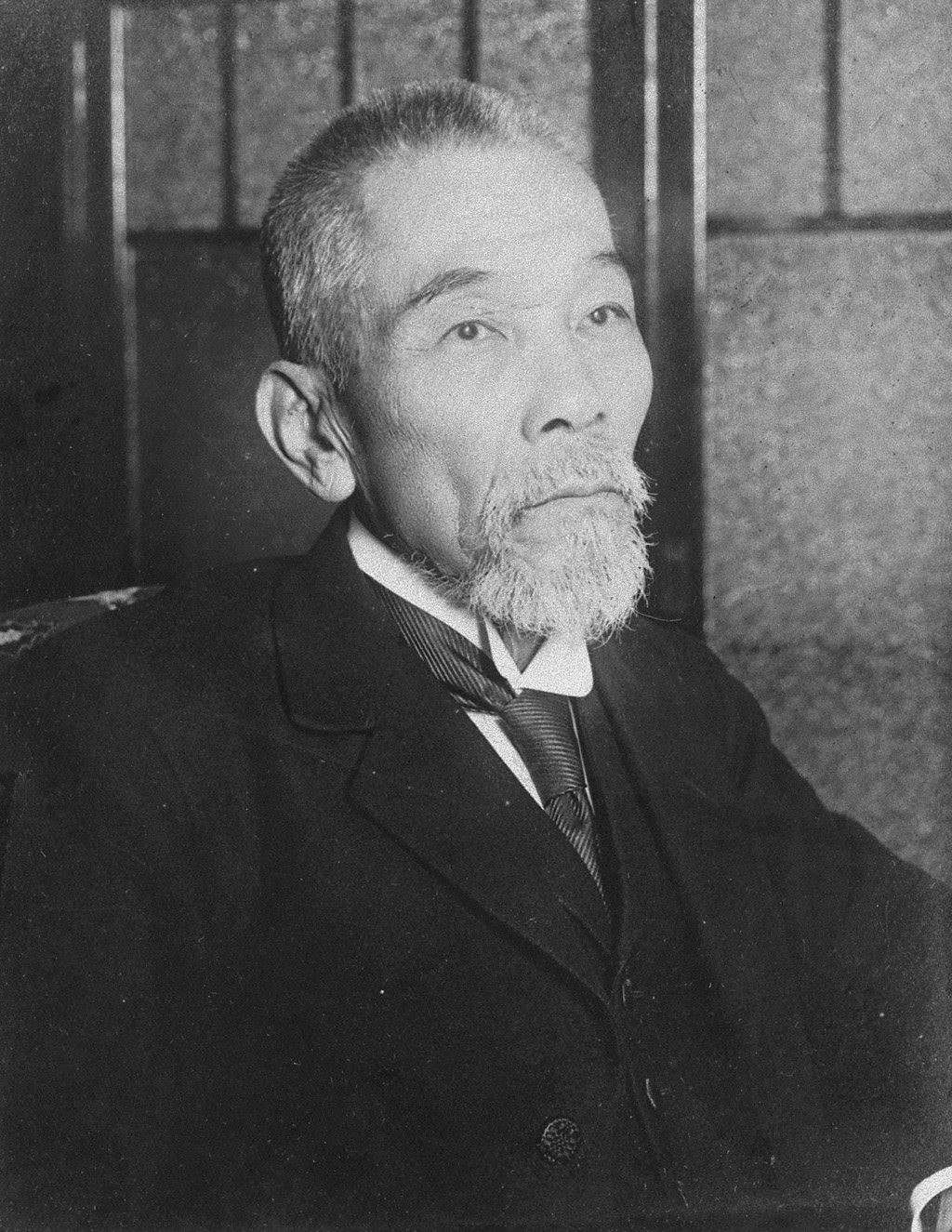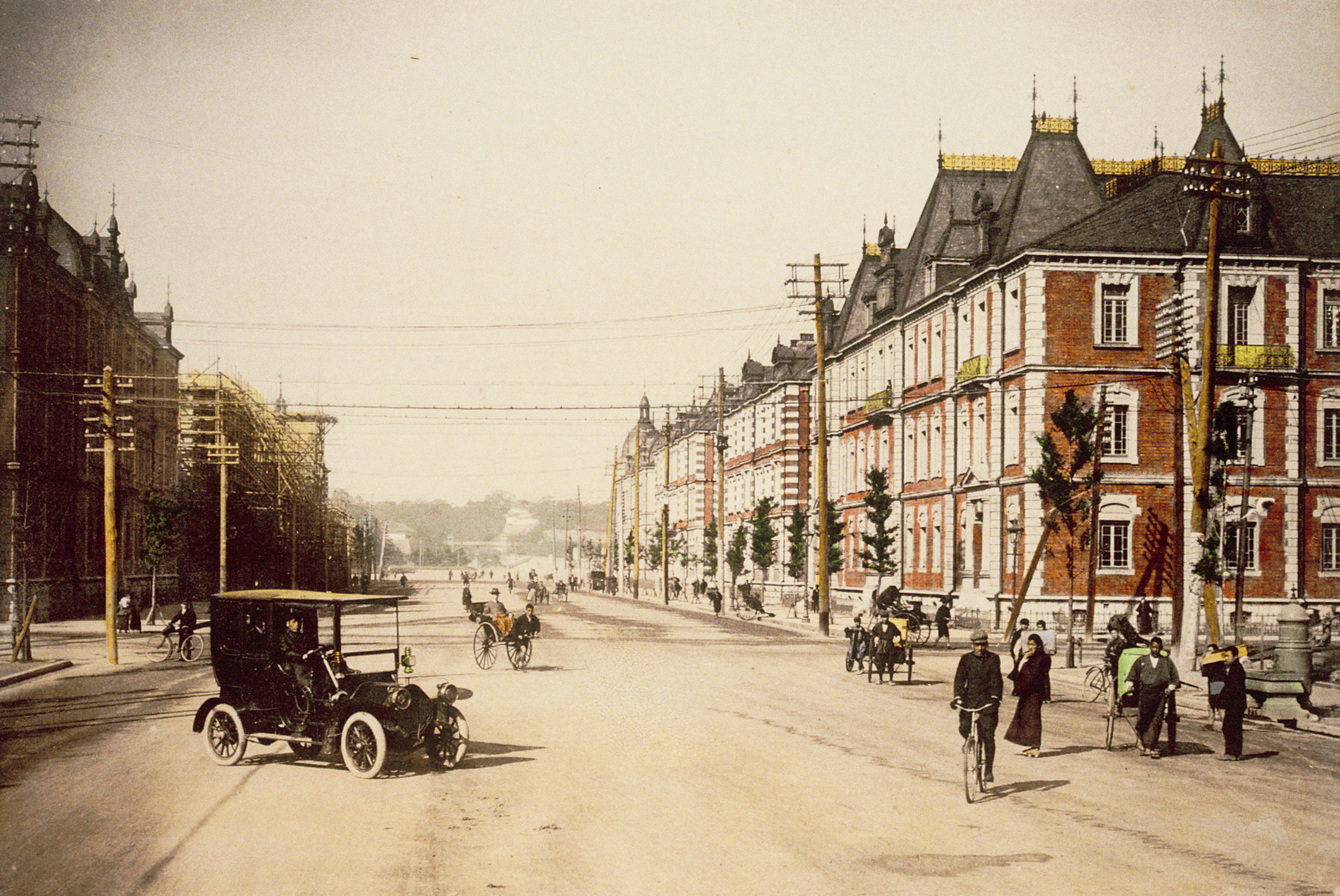|
Nisshō Inoue
was a radical Buddhist preacher of Nichirenism who founded the interwar Japanese far-right militant organization . Contrary to popular belief, he was never an ordained Nichiren priest, but was rather a self-styled preacher whose extremist tenets were widely denounced by Japan's mainline Nichiren Buddhist establishment of the time. Biography Inoue was born Inoue Shirō (later adopting the name Akira and then Nisshō, lit. “Called by the Sun”) in Kawaba, Gunma Prefecture, in 1887, the son of a rural doctor. Educated at Toyo Cooperative (present-day Takushoku University), he abandoned his studies and traveled to Manchuria where he spent time as a vagabond and ultimately found employment from 1909 to 1920 with the South Manchuria Railway. Upon his return to Japan, he first studied to become a Zen priest but then became a follower of Nichiren Buddhism, a conversion that led him to relocate to Miho, Shizuoka Prefecture, in order to study under the Nichiren scholar and nation ... [...More Info...] [...Related Items...] OR: [Wikipedia] [Google] [Baidu] |
Kawaba, Gunma
250px, Road station Kawaba Den-en Plaza is a village located in Gunma Prefecture, Japan. , the village had an estimated population of 3,241 in 1127 households, and a population density of 110 persons per km². The total area of the village is . Geography Located in north-central Gunma, Kawaba is in a mountainous area. Approximately 83% of its area is covered by forests, and five rivers (the Tashiro, Sakura, Tazawa, Usune, and the Mizomata) flow through the village. Kawaba, meaning "the place of the rivers" is thought to be named after its many streams. *Mountains: Mount Hotaka (2158m) *Rivers: Tashiro River, Sakura River, Tazawa River, Usune River, Mizomata River Surrounding municipalities Gunma Prefecture * Numata * Katashina * Minakami Climate Kawaba has a Humid continental climate (Köppen ''Cfb'') characterized by warm summers and cold winters with heavy snowfall. The average annual temperature in Kawaba is 9.1 °C. The average annual rainfall is 1763 mm ... [...More Info...] [...Related Items...] OR: [Wikipedia] [Google] [Baidu] |
Shūmei Ōkawa
was a Japanese nationalist and Pan-Asianist writer, known for his publications on Japanese history, philosophy of religion, Indian philosophy, and colonialism. Background Ōkawa was born in Sakata, Yamagata, Japan in 1886. He graduated from Tokyo Imperial University in 1911, where he had studied Vedic literature and classical Indian philosophy. After graduation, Ōkawa worked for the Imperial Japanese Army General Staff doing translation work. He had a sound knowledge of German, French, English, Sanskrit and Pali. He briefly flirted with socialism in his college years, but in the summer of 1913 he read a copy of Sir Henry Cotton's ''New India, or India in transition'' (1886, revised 1905) which dealt with the contemporary political situation. After reading this book, Ōkawa abandoned "complete cosmopolitanism" (''sekaijin'') for Pan-Asianism. Later that year articles by Anagarika Dharmapala and Maulavi Barkatullah appeared in the magazine ''Michi'', published by Dōka ... [...More Info...] [...Related Items...] OR: [Wikipedia] [Google] [Baidu] |
Rinzai
The Rinzai school ( ja, , Rinzai-shū, zh, t=臨濟宗, s=临济宗, p=Línjì zōng) is one of three sects of Zen in Japanese Buddhism (along with Sōtō and Ōbaku). The Chinese Linji school of Chan was first transmitted to Japan by Myōan Eisai (1141 –1215). Contemporary Japanese Rinzai is derived entirely from the Ōtōkan lineage transmitted through Hakuin Ekaku (1686–1769), who is a major figure in the revival of the Rinzai tradition. History Rinzai is the Japanese line of the Chinese Linji school, which was founded during the Tang dynasty by Linji Yixuan (Japanese: Rinzai Gigen). Kamakura period (1185–1333) Though there were several attempts to establish Rinzai lines in Japan, it first took root in a lasting way through the efforts of the monk Myōan Eisai. In 1168, Myōan Eisai traveled to China, whereafter he studied Tendai for twenty years. In 1187, he went to China again, and returned to establish a Linji lineage, which is known in Japan as Rinzai. Dec ... [...More Info...] [...Related Items...] OR: [Wikipedia] [Google] [Baidu] |
Inukai Tsuyoshi
Inukai Tsuyoshi ( ja, 犬養 毅, 4 June 1855 – 15 May 1932) was a Japanese politician, cabinet minister, and Prime Minister of Japan from 1931 to his assassination in 1932. Inukai was Japan's second oldest prime minister while serving, as he was aged 76 on the day he was murdered, after Kantarō Suzuki (at aged 77). Early life Inukai was born to a samurai family of Niwase Domain, in Niwase village, Bizen Province (now part of Okayama city, Okayama Prefecture), where his father had been a local official and magistrate under the Tokugawa shogunate. In 1876, Inukai travelled to Tokyo and subsequently graduated from the Keio Gijuku (now Keio University) where he specialized in Chinese studies. In his early career, Inukai worked as a journalist for the ''Yūbin Hōchi Shimbun'' (now a sports newspaper subsidiary of the ''Yomiuri Shimbun'') and ''Akita Sakigake Shimpō''. He went with the Imperial Japanese Army to the front during the Satsuma Rebellion as a reporter. Political ... [...More Info...] [...Related Items...] OR: [Wikipedia] [Google] [Baidu] |
Prime Minister Of Japan
The prime minister of Japan ( Japanese: 内閣総理大臣, Hepburn: ''Naikaku Sōri-Daijin'') is the head of government of Japan. The prime minister chairs the Cabinet of Japan and has the ability to select and dismiss its Ministers of State. The prime minister also serves as the civilian commander-in-chief of the Japan Self Defence Forces and as a sitting member of the House of Representatives. The individual is appointed by the emperor of Japan after being nominated by the National Diet and must retain the nomination of the lower house and answer to parliament to remain in office. The position and nature of this title allow the holder to reside in and work at the Prime Minister's Official Residence in Nagatacho, Chiyoda, Tokyo, close to the National Diet Building. Fumio Kishida is the current prime minister of Japan, replacing Yoshihide Suga on 4 October 2021. As of , there have been 102 prime ministers. Designation Abbreviations In Japanese, due to the s ... [...More Info...] [...Related Items...] OR: [Wikipedia] [Google] [Baidu] |
League Of Blood Incident
was a 1932 assassination plot in Japan in which extremists targeted wealthy businessmen and liberal politicians. The group chose twenty victims but succeeded in killing only two: former Finance Minister and head of the Rikken Minseitō political party, Junnosuke Inoue, and the Director-General of Mitsui Holding Company, Dan Takuma. The arrest of the assassins led to the discovery of the existence of a civilian ultranationalist group led by self-styled Buddhist preacher, Nisshō Inoue. Background Born as Inoue Shirō in 1886 in Gunma Prefecture, Nisshō spent his young adult life as a drifter and adventurer, eventually ending up in north and northeast China gathering information for the Japanese military. After a series of mystical experiences in 1923–24, Inoue became convinced that Japan required spiritual rebirth and that he was called to be its savior. He established a school in Ibaraki Prefecture to promote agrarianism and social reform, which gradually evolved into a tr ... [...More Info...] [...Related Items...] OR: [Wikipedia] [Google] [Baidu] |
Dan Takuma
was a Japanese businessman who was Director-General of Mitsui, one of the leading Japanese zaibatsu (family conglomerates). He was a graduate of Massachusetts Institute of Technology and was married to the younger sister of statesman Kaneko Kentarō. During the 1904-1905 Russo-Japanese War, there were some U.S. financiers who wished to profit by lending money to Russia so she could continue her war efforts against Japan. In contrast and in support of ending this war, Frank A. Vanderlip, Jacob Schiff and other U.S. financiers supported President Theodore Roosevelt's successful role as peacemaker between Russia and Japan. Their action was greatly appreciated by many of the leaders of Japan. The early decades of the 1900s were often challenging in terms of U.S. Japan relations. Frank A. Vanderlip and his American and Japanese allies strove to encourage increased business and trade between their nations, which could also enhance the mutual respect and understanding between the U.S. ... [...More Info...] [...Related Items...] OR: [Wikipedia] [Google] [Baidu] |
Zaibatsu
is a Japanese term referring to industrial and financial vertically integrated business conglomerates in the Empire of Japan, whose influence and size allowed control over significant parts of the Japanese economy from the Meiji period until the end of World War II. A ''zaibatsu'' general structure included a family-owned holding company on top, and a bank which financed the other, mostly industrial subsidiaries within them. Although the ''zaibatsu'' played an important role in the Japanese economy from the 1860s to 1945, they increased in number and importance following the Russo-Japanese War of 1904–1905, World War I and Japan's subsequent attempt to conquer East Asia during the inter-war period and World War II. After World War II they were dissolved by the Allied occupation forces and succeeded by the '' keiretsu'' (groups of banks, manufacturers, suppliers, and distributors). Equivalents to the ''zaibatsu'' can still be found in other countries, such as the '' chaeb ... [...More Info...] [...Related Items...] OR: [Wikipedia] [Google] [Baidu] |
Mitsui
is one of the largest ''keiretsu'' in Japan and one of the largest corporate groups in the world. The major companies of the group include Mitsui & Co. ( general trading company), Sumitomo Mitsui Banking Corporation, Nippon Paper Industries, Pokka Sapporo Holdings, Toray Industries, Mitsui Chemicals, Isetan Mitsukoshi Holdings, Sumitomo Mitsui Trust Holdings, Mitsui Engineering & Shipbuilding, Mitsui O.S.K. Lines and Mitsui Fudosan. History Edo period origins Founded by Mitsui Takatoshi (1622–1694), who was the fourth son of a shopkeeperRíkarðsson, Árni (2020). ''Origins of the Zaibatsu conglomerates''. Bachelor’s thesis. Supervisor: Kristín Ingvarsdóttir. Reykjavik, University of Iceland, p. 15. in Matsusaka, in what is now today's Mie prefecture. From his shop, called Echigoya (越後屋), Mitsui Takatoshi's father originally sold miso and ran a pawn shop business. Later, the family would open a second shop in Edo (now called Tokyo). Takatoshi moved to ... [...More Info...] [...Related Items...] OR: [Wikipedia] [Google] [Baidu] |
Junnosuke Inoue
was a Japanese financier and statesman of the Taisho and Showa eras. He was the 9th and 11th Governor of the Bank of Japan (BOJ). Biography Inoue was born in Ōita Prefecture. A graduate of the Imperial University of Tokyo. In 1896, he entered the Bank of Japan. In 1897, Inoue was a BOJ trainee along with Hisaakira Hijikata. Both young men were sent by the bank to learn about British banking practices in London. From 1913-1919, Inoue was head of the Yokohama Specie Bank Inoue was Governor of the Bank of Japan from March 13, 1919 – September 2, 1923 and again from May 10, 1927 – June 1, 1928.BOJList of Governors and Minister of Finance in 1923-1924 and 1929-1931. He briefly presided the Institute of Pacific Relations between Ray Lyman Wilbur nomination as United States Secretary of the Interior and his own second nomination as Japan Minister of Finances. In 1932, Inoue was one of two prominent Japanese assassinated in the League of Blood Incident was a 1932 assassin ... [...More Info...] [...Related Items...] OR: [Wikipedia] [Google] [Baidu] |
Assassination
Assassination is the murder of a prominent or important person, such as a head of state, head of government, politician, world leader, member of a royal family or CEO. The murder of a celebrity, activist, or artist, though they may not have a direct role in matters of the state, may also sometimes be considered an assassination. An assassination may be prompted by political and military motives, or done for financial gain, to avenge a grievance, from a desire to acquire fame or notoriety, or because of a military, security, insurgent or secret police group's command to carry out the assassination. Acts of assassination have been performed since ancient times. A person who carries out an assassination is called an assassin or hitman. Etymology The word ''assassin'' may be derived from '' asasiyyin'' (Arabic: أَسَاسِيِّين, ʾasāsiyyīn) from أَسَاس (ʾasās, "foundation, basis") + ـِيّ (-iyy), meaning "people who are faithful to the fou ... [...More Info...] [...Related Items...] OR: [Wikipedia] [Google] [Baidu] |







